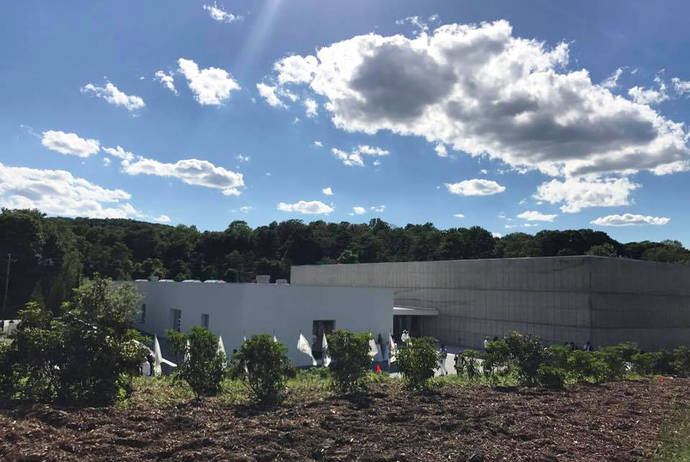Magazzino, which translates to “warehouse” in English, was born thanks to husband and wife Giorgio Spanu and Nancy Olnick and their passion for postwar Italian art. What was in the 1980s a computer factory has acquired today, thanks to the architect Quismondo, a strong architectural identity.
Situated approximately an hour outside of New York City in Cold Spring, Magazzino inaugurated its first show, paying homage to Margherita Stein, the founder of the historic Christian Stein gallery and pioneer of the arte povera movement.
Olnick and Spanu are no strangers to this area. In fact, they are very much a part of the local community. They raised their kids in the Hudson Valley, and they collected important Arte Povera pieces, including Michelangelo Pistoletto, Mario Merz, Alighiero Boetti. Their house, designed by Alberto Campo Baeza, has become an art temple, that reflects their modernist and minimalist style and, at the same time, a homey space where they spend time when they are not in the city. As they explained: “At one point, it became too small for the works that we had, and we then decided to buy an old factory, a warehouse, in 2013.”
Discovering Arte Povera: Artists Clashing Against Industrial Society
“We became interested in Arte Povera in the ‘90s thanks to a friend who advised us to visit the Rivoli castle - the two collectors told us - We saw a show on this conceptual movement, and we fell in love with the works of Giulio Paolini, Luciano Fabro, Marisa Merz, Giovanni Anselmo, and Pier Paolo Calzolari. We started studying this movement, which began at the end of the ‘60s”. “It was in that moment that we met the mythic figure of Margherita Stein, an incredible woman with a taste for contemporary art.”
“For us, she was a great figure who rebelled against the art establishment, against everything that represented classicism; her gallery represented a beacon of the arte povera group,” Spanu and Olnick recounted.
Margherita Stein, in fact, was very fascinated by these artists’ works. They were children of the transitory and changing post “economic miracle” era of the ‘50s. The creations of the Arte Povera movement were characterized by a clear refusal of traditional art, of its techniques and supports, opting instead for poor materials like earth, wood, iron, rags, plastic, and industrial scrap. Nature became the inspiration and one of the themes that artists like Mario Merz dealt with in La natura interloquisce sempre con se stessa? with his famous representation of the Fibonacci sequence.
Visiting Magazzino, The New Art Warehouse
Entering Magazzino an emblematic art work welcomes us: Michelangelo Pistoletto’s Stracci Italiani, from the Olnick Spanu collection. “We had asked the artist to create something for us that was an icon, something that represented Italy and Italian art and that inspired the young artists participating in Olnick Spanu’s Art Program. As Michelangelo puts it, “Poor Italy, always in rags.”
The light that filters in from the warehouse’s large windows matches perfectly with the environment and the works. It’s a mix between nature and industrial architecture that lets us appreciate the installations and extraordinary works of these artists. In Paolini’s Mimesis two symmetrical plaster casts on wood bases recall a sculpture from the classic age. They’re placed one in front of the other, standing in conversation. Mimesis is fueled by a criticism against the concept of uniqueness and inimitability of the work of art.
Walking through the space, we can reflect ourselves in Pistoletto’s mirrored paintings, which were created in the ‘60s. These represent the inclusion of the spectator and the surrounding environment in the work, which allows them to become, as Pistoletto says “the self-portrait of the world.”
In Che fare? Mario Merz uses artificial neon lighting together with wax and aluminum: “It’s an emblematic and important line that Lenin first said in front of the politburo. These words were directed towards the group of the arte povera manifest,” Spanu explains.
Another one of the most admirable pieces that Giorgio, Nancy, and Vittorio Calabrese, the Director of Magazzino unveiled to the public was Paolini’s Amore e Psiche: “During our first visit to Rivoli, we fell in love with this work and decided to begin the collection".
Magazzino, A Point of Encounter Between Italian and American Artists
Vittorio Calabrese, Nancy, and Giorgio underlined that “this space is not a museum or a private foundation, but it is a point of reference between artists, whether or not they’re Italian, and between people who want to enjoy an art collection for free and, most of all, to discover more about arte povera.”
The Hudson Valley has been involved in the art world for quite some time. In fact, in the 19th century, a “school” of American painters was born there. Only a few train stops away from Cold Spring it is possible to visit other art spaces and cultural centers dedicated to contemporary works: the Dia:Beacon in Beacon and the Storm King Art Center in Mountainville.
Giorgio Spanu himself, also as Chairman of Casa Italiana Zerilli-Marimò, has repeatedly had the chance to show his earnest commitment to the arts and the educational sector.
What is Magazzino’s next step? “We’re preparing a great retrospective, the first in the United States, on Sardinian art, Maria Lai, at the same time as the MAXXI Museum in Rome in 2019".
See also i-Italy video interview with Nancy Olnick and Giorgio Spanu by Letizia Airos >>>
-----
Admission is free by appointment only.







































